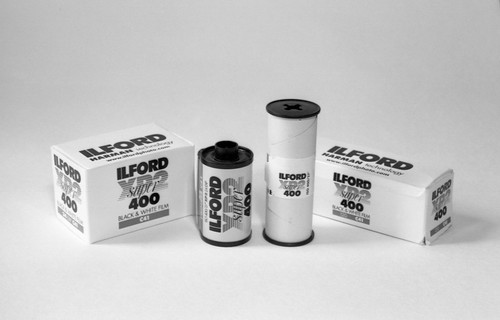 |
| Ilford XP2 Super, shot on XP2 Super, 35mm and medium format |
WHY XP2 SUPER IS DIFFERENT
XP2 SUPER is a chromogenic film. This means that the dyes which make up the image are formed during development rather than being present in the film or added later. The extremely wide exposure latitude of XP2 SUPER is the result of the unique relationship between exposure and grain in chromogenic films. The best balance of sharpness and grain is obtained when XP2 SUPER is exposed at EI 400/27. However, down-rated or overexposed XP2 SUPER negatives have finer grain, the opposite of that expected and obtained with conventional films. Up-rated or underexposed XP2 SUPER negatives have only a slight loss in quality. Furthermore, standard C41 processing is recommended for the whole of the exposure range.
Ilford XP2 Super data sheet
At some point over the last four decades, all the big four film manufacturers marketed
chromogenic black and white films: Agfapan Vario XL was the first such film, followed by Ilford with XP1; Kodak produced BW400CN and Fuji had Neopan 400CN (although this film itself is made in Europe with Ilford being involved in its manufacture). The reasons that chromogenic black and white films were developed surround the simple logistics of standardised C41 negative processing: once this infrastructure was established - the typical high street one hour photo - the rationale for a black and white film which could be processed in this way was clear. Chromogenic films had an appeal to two distinct types of customers: for the amateur, wanting to use black and white but unwilling to either pay the premium for black and white processing or endure the wait while the film to sent to a specialist lab; for professionals, the film could be developed alongside colour negative film and lab prints from chromogenic film could be treated as proofs for later bespoke printing by hand in a darkroom. In some respects, XP2 Super's distinct features - C41 processing and wide latitude - make it an ideal choice for someone wanting to shoot black and white film for the first time. Ilford XP1 400 was announced at Photokina in 1980, a year after Agfapan Vario XL, and a year after Ilford's centenary. The first version had its own chemistry as well as being able to be processed in standard C41 chemicals. XP2 succeeded XP1 in 1991; the film was "updated" with no name change in 1996; and it reached the current iteration of
Ilford XP2 Super twenty years ago this year in 1998. The
Super suffix for XP2 would appear to be the equivalent of the 'Plus' versions of HP5 and FP4.
Although of any particular film stock HP5 Plus is almost certainly the film I've used more than any other, Ilford XP2 Super may be the one film I used most intensely, for a number of years when I didn't have access to a darkroom and did not develop at home: I used it as my standard black and white film, mostly through the early 2000s. Since returning to developing negatives myself, I've not used XP2 very much, but, at the end of last year, I bought a brick of 10 24-exposure rolls of 35mm XP2 Super at a clearance price due to being out-dated. The films were dated September 2016 - and as it was then only a year out of date, I've made no adjustments in exposure to compensate for age - and these films were priced at £1.50 per roll, and even though this was closer to £2 each with postage, this was still very economical, and I had no doubt that the age of the film would be as close as negligible in terms of its results.
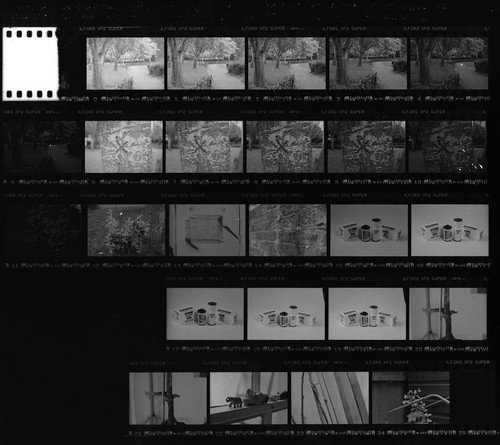 |
| Ilford XP2 Super latitude test contact sheet (C41 process) |
One of Ilford's claims for XP2 Super is that it has exceptional latitude and can be exposed at a range of exposure indexes with no adjustment in processing times:
XP2 SUPER film has a speed rating of ISO 400/27° (400ASA, 27DIN, EI 400/27) to daylight. [...] Although rated at ISO 400/27°, XP2 SUPER can be exposed over the range EI 50/18–800/30. When higher speed is needed, XP2 SUPER can be rated at up to EI 800/30. For finer grain, when speed is less important, rate the film at EI 200/24, although for finest grain it can be rated as low as EI 50/18 if required.
Although I had used XP2 Super a great deal in the past, I hadn't made any kind of systematic tests at the time. Like other films written about on this blog, for this post, I wanted to make some tests as to the film's capabilities, and I began with a latitude test. I shot a roll of XP2 Super with two sequences of six frames rated at exposure indexes rated 50/100/200/400/800/1600. The rest of the roll was rated at 200 and this was processed professionally with C41 development. The results of the tests on this post were scanned; a more comprehensive set of tests would include darkroom printing, but the scanned negatives should provide some relatively comparable results.
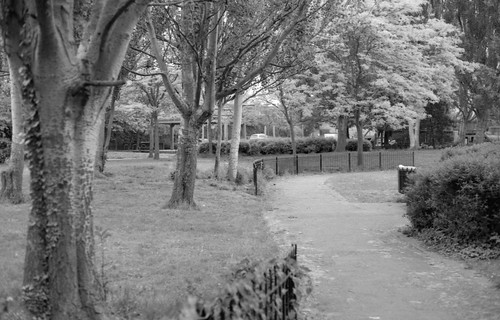 |
| Ilford XP2 Super rated EI 50 |
The suggestion from Ilford's data sheet with regards to the relationship of density to fineness of grain does appear to hold true: I've never had a reason to rate XP2 as low as EI 50 before, but the frames so rated have a smoothness to them that might seem surprising for a 400 ISO film. This is apparently due to the way that the dye clouds which replace the silver in processing overlap. In practice, however XP2 Super is rated, this does have the effect that the grain is finer in
overexposed areas, while the grain is more pronounced in the shadow areas, the opposite effect to the case with traditional black and white negative film, where denser areas provide more visible grain. One aspect of this unique peculiarity makes XP2 Super particularly good at rendering skies in landscapes with much smoother tones than one might achieve with a similar speed conventional black and white film, for example. However, when rated at an exposure index of 50 or 100 it appears there is some compression of the tonal range; the date sheet has a curve with a very shallow shoulder. In addition, it would appear that rating the film for 'finest grain' is at the expense of sharpness; this may seem counter-intuitive, but, on consideration, a denser negative would logically be less sharp than a thinner one, though how great a difference one might perceive in a print or scan is not something I've tested for here.
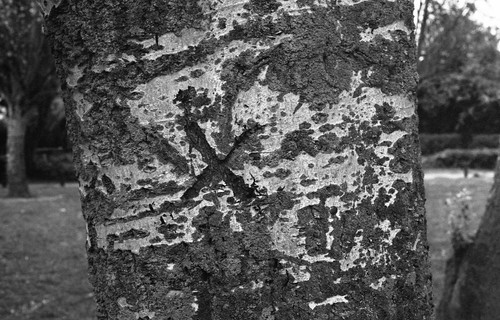 |
| Ilford XP2 Super rated EI 800 |
At the other end of the exposure scale, grain appears to become apparent in the mid-tones through to the shadows when rated at EI 800, but squeezing an extra stop from the film in low light conditions without any change to processing - and on the same roll as frames exposed at different ratings - is potentially very useful. Ilford do not recommend push processing with Ilford XP2 Super, and I have not test the feasibility of this with C41 processing. However the frames rated EI 1600 displayed quite a pronounced grain, which my tests, looks quite visually unappealing - unlike some traditional black and white films, where the visual texture of the film grain adds something to the image, rather than detracts.
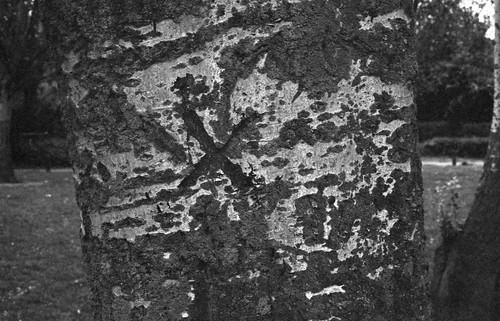 |
| Ilford XP2 Super rated EI 1600 |
The remainder of this test roll I shot at EI 200, and this became my standard practice when available light allowed while shooting a number of rolls of XP2 Super subsequent to making the latitude test.
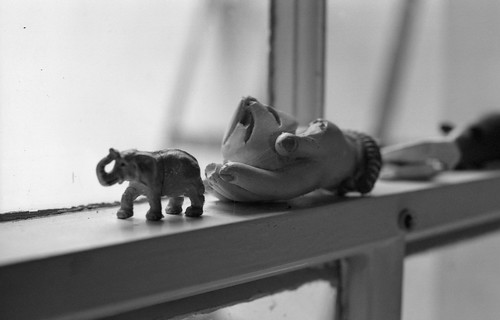 |
| Ilford XP2 Super, rated EI 200 |
One aspect of the film that I was keen to test for this post was the difference between processing XP2 Super as intended by C41, and compare this to XP2 Super developed using traditional black and white chemicals. For this second latitude test, I used the same camera (a
Canon A-1) and the same ratings of 50/100/200/400/800/1600 for two successive series of six shots. Again, the remainder of the roll was shot at a rating of EI 200. Ilford
does not recommend using black and white chemicals to process XP2, but, like
any film, it's based on a silver negative: as with a colour negative film, the developed silver is then bleached and replaced by dyes; unlike a colour negative, of course, there's only one layer. Therefore, there's no reason that it cannot be developed as a black and white negative, but it is not intended for this and so it may not necessarily give the best results - which was something I wanted to test (and unless otherwise stated all the images on this post were from C41 processed negatives). I have previously used
stand development with Rodinal with XP2, a good all-round method for developing almost any film, but there are
listings on the Massive Dev Chart for a standard small tank development routine with intermittent agitation. The listing for Rodinal is given as 18 minutes at 20ºC at a dilution of 1+25.
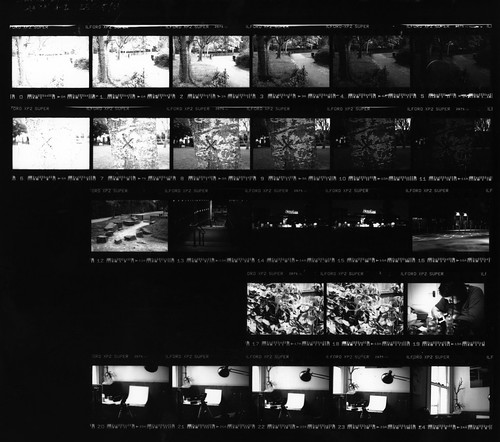 |
| Ilford XP2 Super latitude test contact sheet (developed in R09) |
In the event, for the test roll in black and white chemicals, I developed the film for two minutes longer at a degree cooler in temperature. With the two latitude tests, I printed contact sheets on variable contrast paper without a contrast filter, with the result that these would be the equivalent of using grade 2 paper. The difference between the use of black and white chemicals and C41 processing was immediately clear: with black and white chemicals the film's contrast is notably greater, and its latitude appears less. In both tests, the frames rated 1600, two stops underexposed, shadow detail appears to dramatically drop off, but this was even more marked with the film developed in R09. One final note on the differences, interestingly, is that there appears to be less base fog with black and white chemicals, which may increase the overall contrast. Further, I did not try push-processing in black and white chemicals (as with C41 development) due in part to the already long development times.
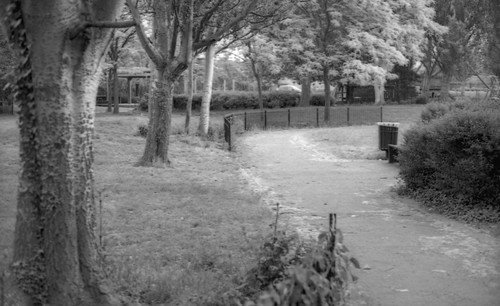 |
| Ilford XP2 Super, rated EI 50, developed with R09 |
Scanning the negatives developed in RO9, one issue I had was that the density in the highlight areas resulted in noise, which, while distinct from the grain itself, made it difficult to assess the appearance of grain when developed in traditional black and white chemicals. It was immediately obvious that the particular characteristics of XP2 Super are as a direct result of being developed by the C41 process: in black and white chemicals the results are fairly unremarkable. However, some of the images that were rated at EI 200 rather than box speed still had a relatively smooth, fine-grained appearance, and possibly, if not developing XP2 Super as colour negative, this procedure might give the best results.
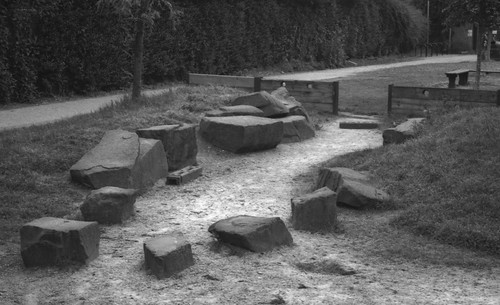 |
| Ilford XP2 Super, rated EI 200, developed with R09 |
Other black and white developers will also work with XP2 Super: the
Massive Dev Chart has a limited list. One developer that I use frequently not on the list is Ilfotec LC29; I've only used this for one roll of Ilford XP2 (not Super, it had a 'develop before' date of Nov 1996) and made a calculated guess of a dilution of 1+29 with a time of 14 minutes at 18ºC. This worked well enough but I would want to make more tests with Ilfotec LC29 before recommending it with these times and dilutions.
 |
| Voigtländer Avus with Ilford XP2 (6x9 medium format) developed in Ilfotec LC29 |
In terms of XP2 Super's specific characteristics with C41 processing, its latitude can sometimes produce images which appear 'flat' with a fairly straight print or scan, that is without increasing the contrast - or other manipulation such as dodging and burning. The contact sheet of the C41-processed latitude test film above shows this, especially when compared to the black and white processed film. This latitude is a benefit when shooting scenes with a wide range subject brightness range: it's especially good for maintaining detail in skies for example. The image below has fairly good modelling in the clouds, which, although obscuring the sun, were brightly lit against the overcast landscape of burnt grass, and, with a small amount of digital burning in (only useful if the detail is there to begin with), has the sort of effect one might perhaps achieve with a light yellow filter. In low-light scenes like night time urban settings, which often have isolated highlights and deep shadow areas, XP2 Super does seem to be quite good at managing these wide variations in illumination (it does suffer reciprocity law failure, but the night shots on this post were taken handheld, without long exposures; also, I haven't made accurate comparisons between C41 and R09 processing for such subjects).
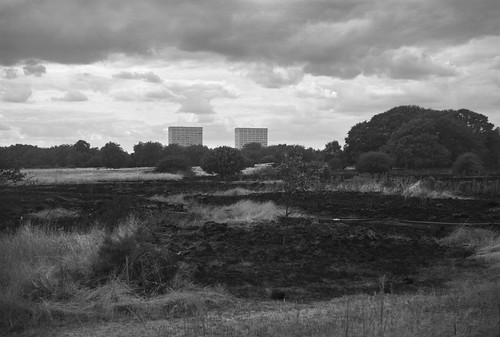 |
| Voigtländer Bessa RF (6x9 medium format) with Ilford XP2 Super |
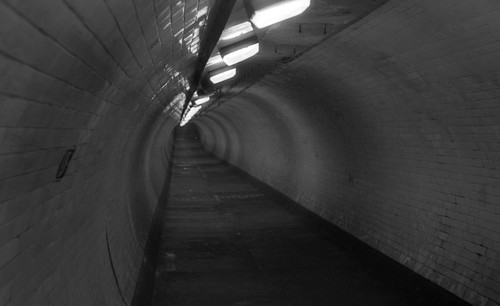 |
| Zenit 11 with Ilford XP2 Super |
When Kodak announced that BW400CN was to be discontinued in 2014, Ilford took the opportunity to produce a
comparison sheet. One of the obvious advantages of Ilford's chromogenic film over Kodak's always was that it was available in medium format as well as 35mm (it is also now available in single use cameras; XP2 was once available in sheet film but this was one format I have neither seen or used). The other notable points of comparison are XP2 Super's wide exposure range: the sheet gives BW400CN as "400 – Not specified in
technical data". In addition, BW400CN was coated onto a standard colour negative orange base, which one might imagine to be less than ideal for printing on black and white variable contrast paper, as well as for scanning. Ilford's film has a pink base, which varies in intensity depending on wash times - some of my negatives look almost clear or at least a light grey without much discernible colour, while others are quite pink. Ilford XP2 Super has a fairly distinct place in the film market now, a niche which it shares with Fuji Neopan 400CN (which, although not confirmed by Ilford, is,
according to some, the same emulsion). One would hope that its distinct characteristics should mean that XP2 Super has a place in Ilford's range of films for the foreseeable future.
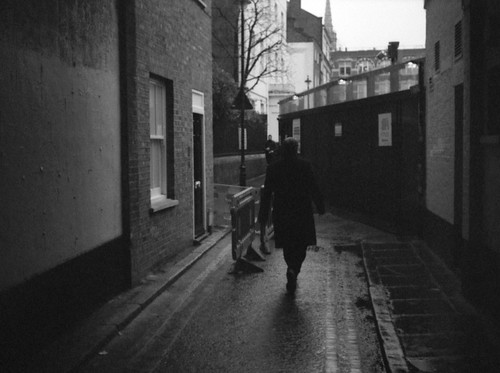 |
| Belomo Agat 18K with Ilford XP2 Super |
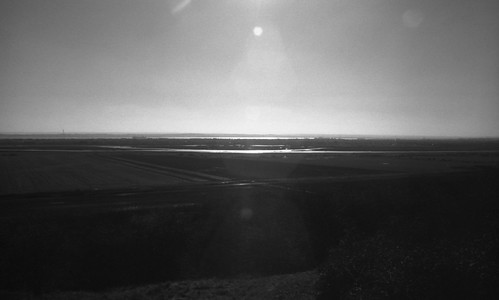 |
| Praktica nova I with Ilford XP2 Super developed in R09 One Shot |
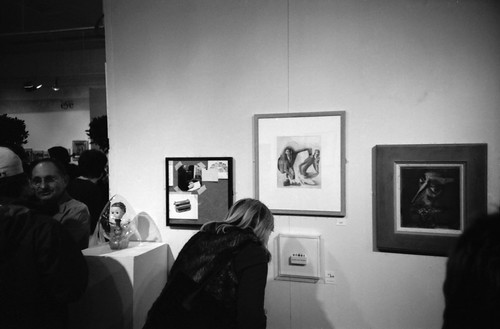 |
| Lomo LCA with Ilford XP2 Super |
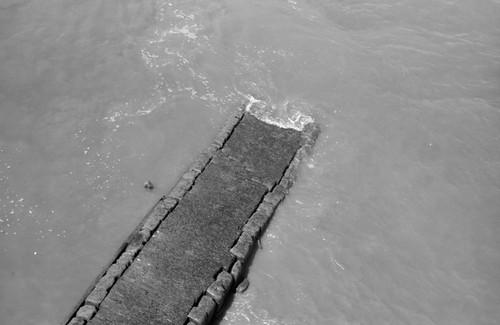 |
| Zenit 11 with Ilford XP2 Super |
 |
| Kiev-4 with Ilford XP2 Super |
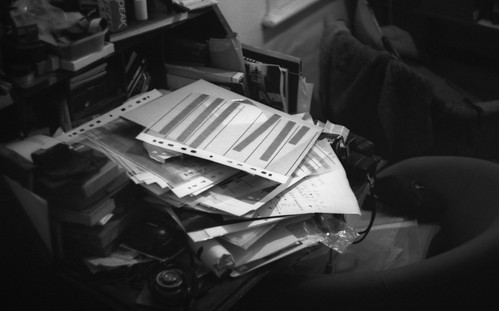 |
| Kiev-4 with Ilford XP2 Super developed in Fomadon R09 |
 |
| Canon A-1 with Ilford XP2 Super (scan from lab print) |
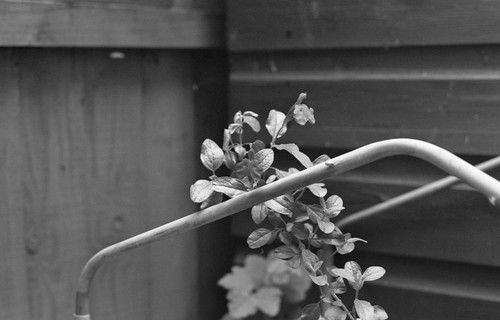 |
| Canon A-1 with Ilford XP2 Super |
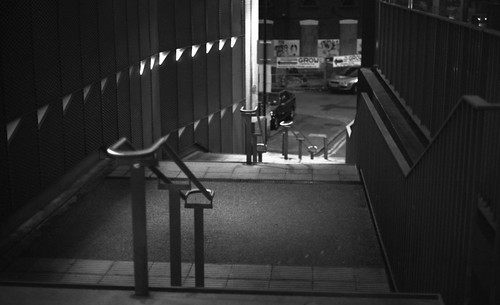 |
| Canon A-1 with Ilford XP2 Super developed in Fomadon R09 |
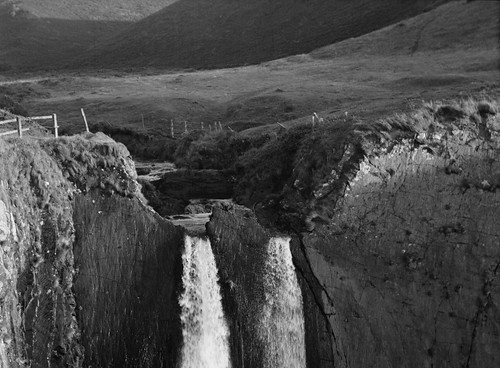 |
| Wallace Heaton Zodel camera (rollfilm back with 6x4.5 mask), Ilford XP2 Super |
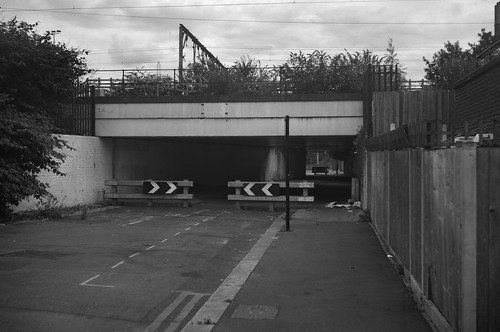 |
| Voigtländer Bessa RF (6x9 medium format) with Ilford XP2 Super |
Ilford XP2 Super - part two
Sources/further reading
Ilford XP2 Super data sheet
XP2 Super/BW400CN comparison sheet
In Praise of XP2 Super - Richard Pickup
Ilford XP2 - an under-appreciated film - The Web Darkroom
How to shoot Ilford XP2 Super - The Online Photographer
Ilford XP2 Super in Black & White Chemistry - Christopher Moss






















